5 Modern Floral Arrangements Inspired by History
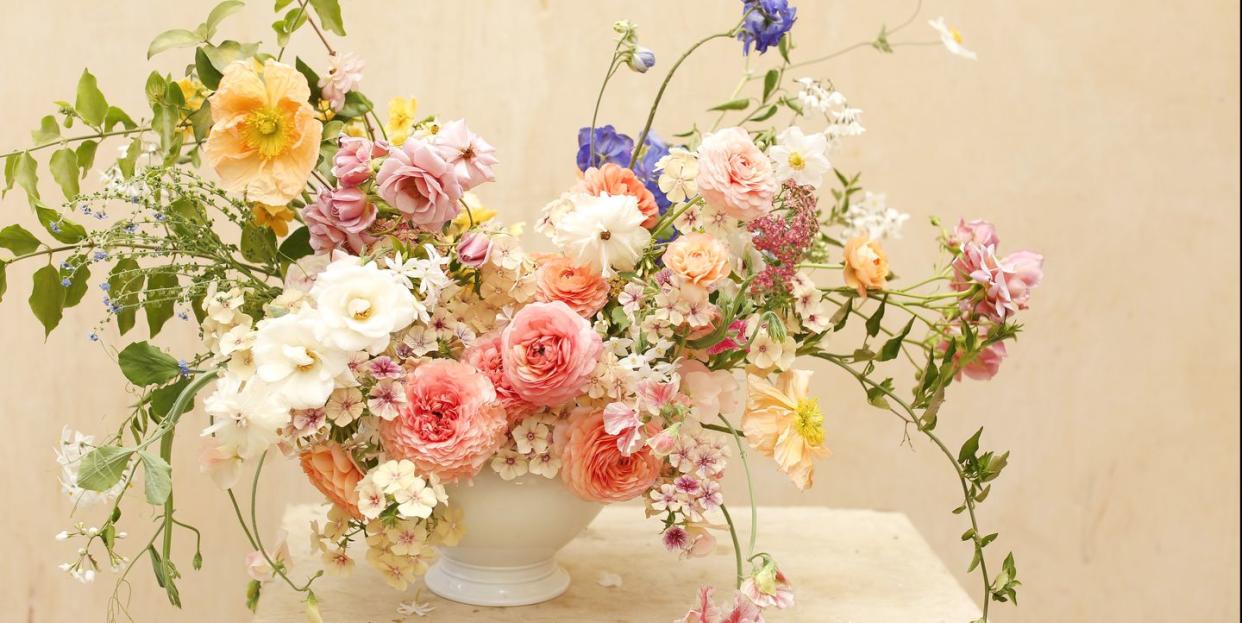
The art of arranging blooms, branches, and other ephemera from nature has long been an art form: Bas-relief carvings in the tombs of Egyptian pharaohs depict lotus and other flowers in vases, the ancient Greeks' talents were on full display with their celebratory wreaths and garlands, and the Byzantines were known for incorporating fruit and vegetables into their elaborate floral displays. In China, flower arranging is believed to have begun as early as the Han dynasty, which was the early 200's B.C.E. Florals were used for medicinal purposes and as a religious act—blooms were a way to decorate altars by Buddhists, Taoists, and Confucianists.
Ancient Romans used blooms for many religious ceremonies, but also loved them for parties, and were particularly fond of roses. It is said that rose petals would be scattered (sometimes knee-deep!) over floors during celebrations, just as done during wedding ceremonies, albeit less dramatically, today. The Romans also loved wreaths, like the Greeks, but incorporated more exotic flowers for the time, like ivy, crocus, and oleander. In Japan, during the 7th century, it became tradition to offer blooms to Buddha, and the Ikenobō school, the oldest to be founded for studying floral art, was started by Ono no Imoko, a Japanese envoy to China.
During the Renaissance period, the art of flower arranging became more precise and even more elaborate. Low, tight bouquets and pyramid shapes became popular in arrangements, while during the 17th century, explorations of new lands introduced new plants to Europeans, making horticulture a popular pastime. Arrangements of blooms became immortalized in still-life paintings, particularly in those done by artists like Jan Brueghel, Van Beheren, and William Kalf in Flanders and Holland. During the 18th century, arrangements being created in England and France became smaller and more delicate in design, as entertaining of guests were done in salons of homes. The Rococo movement in France also resulted in a more feminine and dainty style of bouquets so as to match the dress of that time.
During the Victorian era, it became part of a young lady's education to master the art of flower arranging, as it was customary during this time to refresh a home's florals once a week. Small bouquets, called nosegays, were carried by ladies, and flowers were assigned meanings, allowing for messages to be passed between friends and lovers with even the smallest arrangements. In 1907, Gertrude Jekyll penned Flower Decoration in the House as a guide to the at-home arranger, and the popularity of garden clubs as a social and horticultural outlet and the availability of flower shows in the United States began to rise during the 20th century.
What is it about a thoughtfully-curated arrangement that can soften the senses and immediately transform an interior? Even a simple vase filled with flowers cut straight from the garden transports its viewer and lifts the spirits, and it is this desire to constantly be close to nature, especially within our homes, that makes the art of floral design so important. Not to mention, they are used to mark every special occasion and celebration. So, how do floral designers today take the past and incorporate these styles into their work today? We tapped five top-tier luminaries from around the world to reimagine the arrangements of different time periods for today.
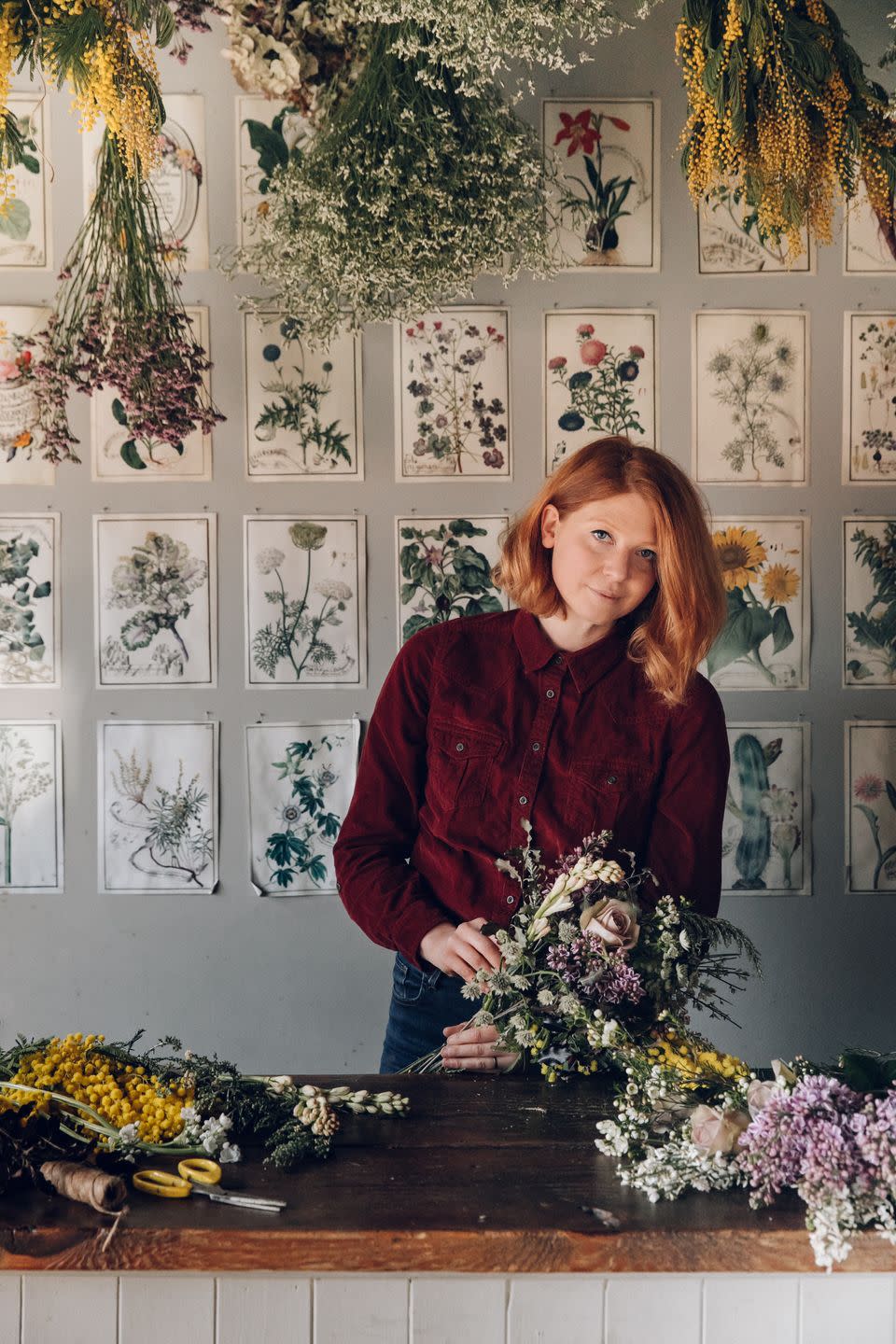
Swallows & Damsons
The Florist: Anna Potter of Swallows & Damsons has been enchanted with flowers since childhood and her daily wanderings through her grandmother's rose garden. She has been creating garden-style arrangements for the past twelve years in her shop in Yorkshire, England.
The Inspiration: 17th century Golden Age
The Florals: Amaryllis, Anemones, Ranunculus, Tulips, Hellebores, Icelandic poppies, Vibernum Tinus, Lingustrum berries, and Wild honeysuckle berries
VERANDA: What do you love about this time period, and what inspires you? What elements of it did you directly draw from when creating this arrangement, and how did you modernize these elements?
Swallows & Damsons: "The Dutch Masters have always been an inspiration, from before I’d even worked with flowers and was studying fine art. The way shadows conceal parts of the arrangement, the eclectic mix of flowers, fruit, bugs, cobwebs, and animal carcasses. The symbolism for life and death and for times of abundance or hardship. Typically these paintings would have been created over the course of a year - using the most exquisite blooms from each season to create an almost fantasy image of an impossible arrangement. To add a more modern touch, I’ve focused on purely seasonal flowers, avoiding anything out of the winter and spring seasons—celebrating seasonality and the opulent look that can be found at any one time rather than reaching outside of the here and now and glorifying blooms that would need to be force grown or imported a long distance."
VERANDA: Do you typically draw inspiration for your work from past time periods? What is it about looking back that helps you look forward?
Swallows & Damsons: "From any period in history, I have found when art has been created to express a depth that goes beyond our day-to-day and touches something almost sublime, it surpasses time and can feel completely relevant now. These works are truly inspiring, and they almost free something in my creative process that allows new ideas to flow. Floral design, in my opinion, is the most effective when it points towards the extraordinary. Not because it uses the most sought-after flowers or has a fashionable edge, but rather it weaves a narrative within it that can reach out and offer a signpost that enables us to look within ourselves."
VERANDA: Describe your creative process – what are some things you always do when creating an arrangement, whether it is in the development stage or something technical?
Swallows & Damsons: "Always look to nature first. What’s happening outside, the season, what’s abundant at any one time. The more I get to know and work with flowers the more I appreciate their irregular nature and have learned to embrace this rather than fight against it. It’s such a joy to work with crazy bends, droopy heads, and kinks in creating something rather than fighting with this and trying to generate something straight and formal. So this is always the starting point creatively—to pay attention and let the flowers lead."
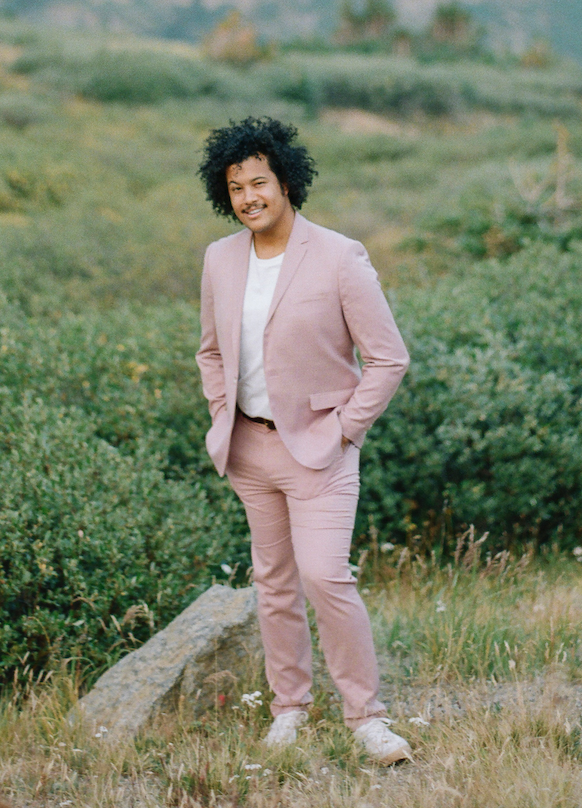
Shean Strong
The Florist: Shean Strong, an Atlanta-based designer, started arranging flowers as a creative outlet while studying Biochemistry in school and draws inspiration for his romantic arrangements through his extensive travels.
The Inspiration: The Empire Period
The Florals: Icelandic poppies, Japanese hellebores, Begonias, French tulips, and Chocolate geraniums
VERANDA: What do you love about this time period, and what inspires you? What elements of it did you directly draw from when creating this arrangement, and how did you modernize these elements?
Shean Strong: "The Empire Period and the revival of the Classical Period was a departure of neoclassical norms with beauty emphasized by linear and masculine arrangements. I love being able to juxtapose masculine shapes with a feminine fluidity. When trying to modernize classical floral silhouettes, it is important to think of the color story and the use of light. Your color selection can instantly modernize a classical form and change the whole mood of an arrangement."
VERANDA: Do you typically draw inspiration for your work from past time periods? What is it about looking back that helps you look forward?
Shean Strong: "I’m inspired by the importance of flowers throughout history while designing for the future. There, you find beautiful and foundational design elements that are timeless for a reason. As a designer, it's important to understand those design rules. Once you have a general understanding, you can bend and manipulate the rules to create something fresh, with a nod to the past."
VERANDA: When people look back on this current time we are in and the installations and arrangement styles that came out of it, what do you think they will take away from it? In other words, what will you and your colleagues’ mark be on the evolution of floral design?
Shean Strong: "Currently, there is a renaissance of floral design taking place - people are being drawn to the creative process, the mindfulness and connection with nature that arranging flowers brings. The designs of today reflect that with organic movement, shape, and variation in our arrangements and installations.
This is a very special time in the floral industry. As designers, we have access to more floral products, and we’re mixing textiles and shapes in new, grandiose ways—but we are also encouraging people to bring flowers into their everyday lives. I think the “at-home” designer, someone arranging flowers for their home or who attends a workshop for their personal enrichment, will stay inspired and be a part of the floral world for years to come."
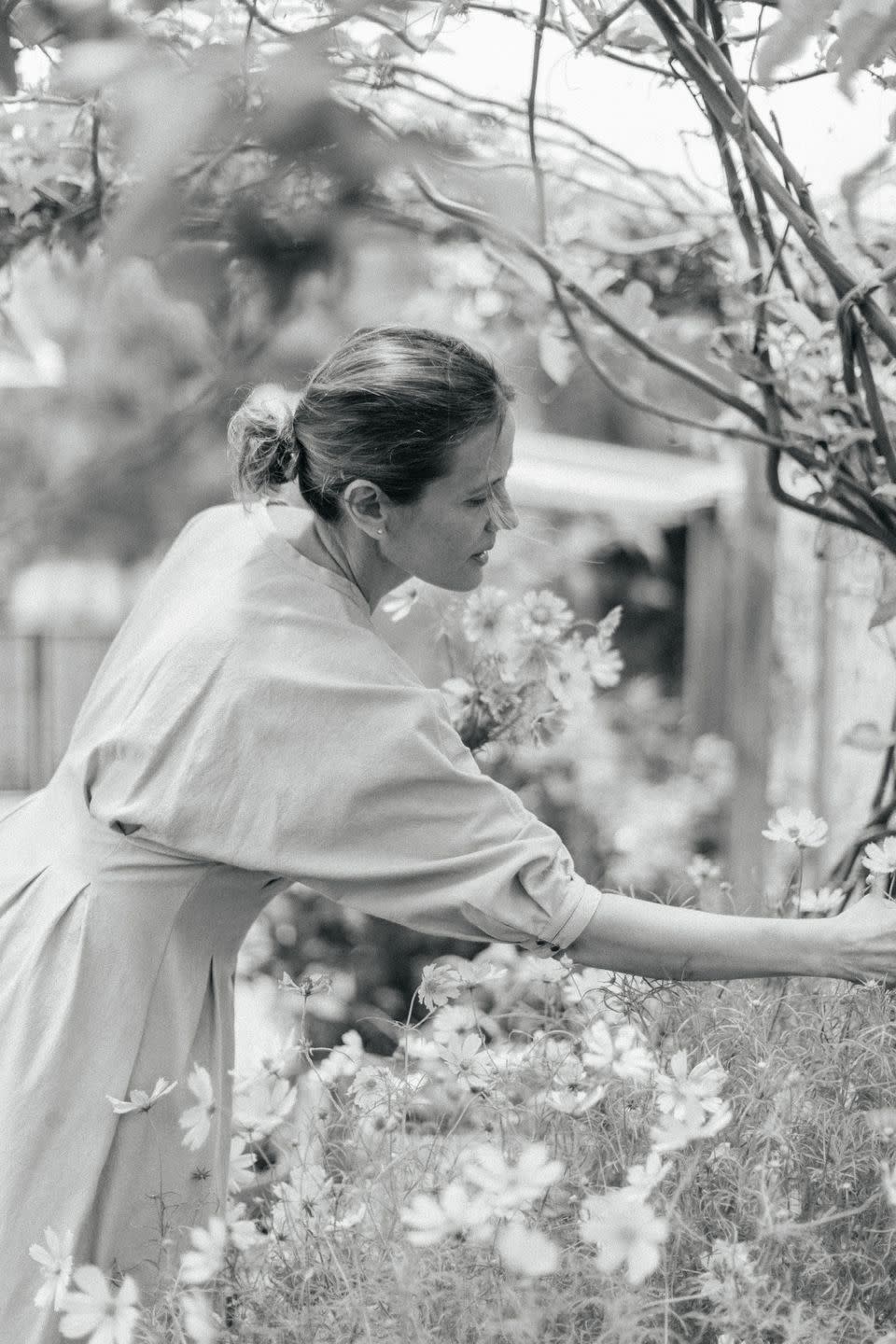
La Musa de las Floras
The Florist: Gabriela Salazar founded La Musa de las Floras after moving back to Mexico from London where she was designing architectural interiors. The power of flowers to transform a space led her to flower arranging and growing her own blooms.
The Inspiration: French Realism
The Florals: Ranunculus, Phlox creme brûlée, Poppies, Roses, Sweet peas, Jasmine, Delphinium, Yarrow
VERANDA: What do you love about this time period, and what inspires you? What elements of it did you directly draw from when creating this arrangement, and how did you modernize these elements?
La Musa de las Floras: "Realism was looking to represent reality with no masks - they valued the beauty of 'imperfection' - not in a sad way, but finding beauty in common things, in situations of everyday life. The way I approach flowers and designing with flowers has to do very much with this approach. I love flowers at all stages, and I love their imperfections. I like to design with flowers that are just opening mixed with some at their maximum bloom, and others that are fading. I simply love the texture and the way color changes through a flower’s life. I don’t see myself designing with just perfect flowers at their maximum beauty, because I find a lot of inspiration in the complete cycle of nature."
VERANDA: Describe your creative process – what are some things you always do when creating an arrangement, whether it is in the development stage or something technical?
La Musa de las Floras: "I like building my arrangements always allowing each flower to have its own space to breathe in the arrangement. For me, designing is not a mechanical process - I like to observe each bloom and let the flower guide me. If a flower has soft and delicate petals, it should have more air and space so it doesn’t get bruised or damaged. Or if a flower is small and more resilient, she can be support for other flowers. For me, nature is my muse, and I learn observing nature."
VERANDA: When people look back on this current time we are in and the installations and arrangement styles that came out of it, what do you think they will take away from it? In other words, what will you and your colleagues’ mark be on the evolution of floral design?
La Musa de las Floras: "I believe we are changing the floral design to a more natural, less rigid way of designing, and respect for nature is becoming a really important part of the way we think about floral design."
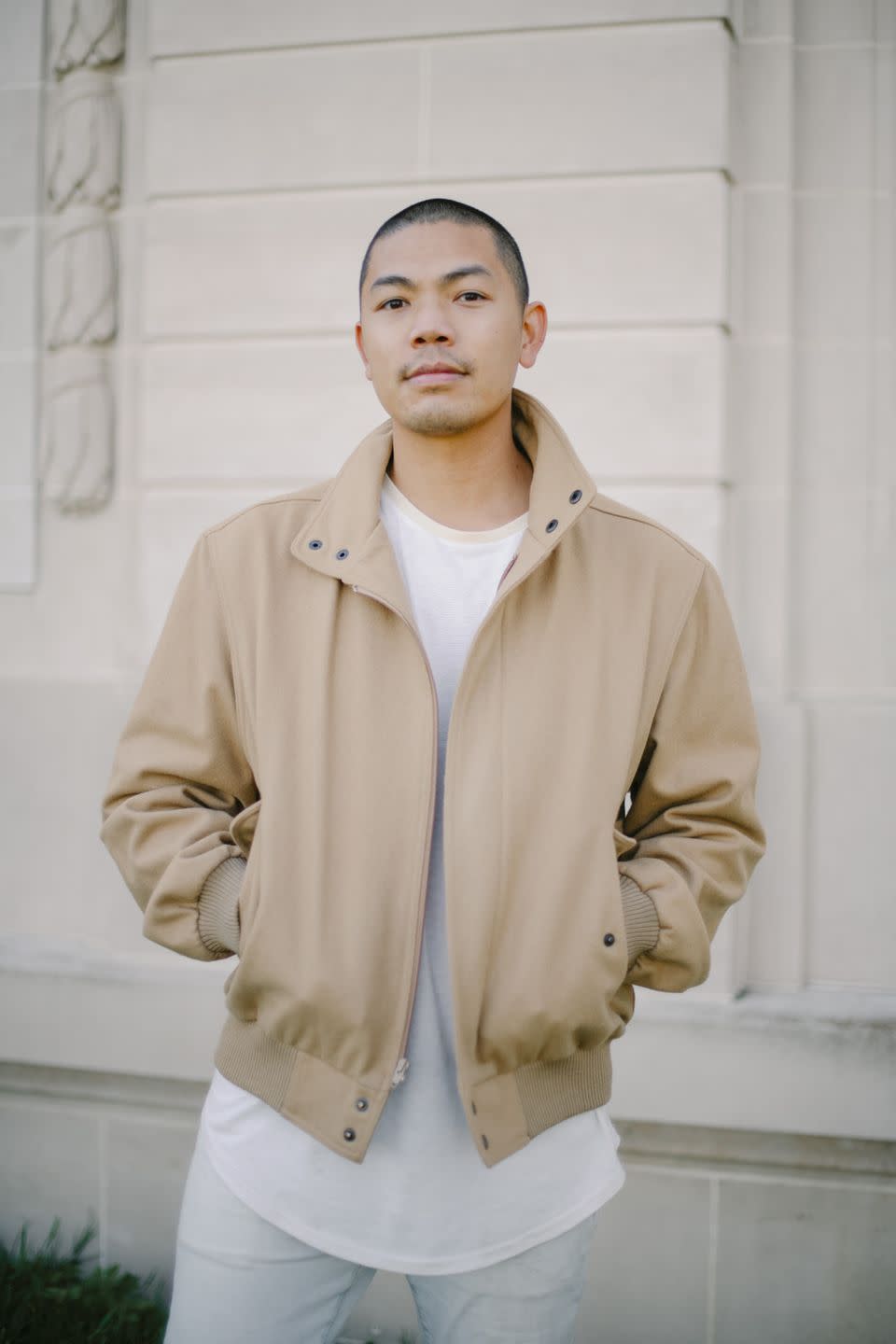
Lambert Floral Studio
The Florist: Sammy Go of Lambert Floral Studio in San Francisco studied Landscape Architecture in college and discovered the artistic pull of plants and flowers, especially after working with a florist to design her own garden which led to a mentorship in floral design.
The Inspiration: Chinese Common Era
The Florals: Camellias, Bamboo, Sweet peas, and Eucalyptus
VERANDA: What do you love about this time period, and what inspires you? What elements of it did you directly draw from when creating this arrangement, and how did you modernize these elements?
Lambert Floral Studio: "I am inspired most by the holistic approach to floral design—Chinese florists in the Sung Dynasty were as concerned with the appearance of their finished arrangement as they were with their experience creating it. In this way, their flowers are imbued with an intentional imprint of their artistic sense of self. I’m more interested in exploring how the flowers I create communicate our state of being – this is so fascinating because as florists we are collaging with found materials that already possess so much beauty. As we arrange, our choices are a contribution of our state-of-being. When I’m stressed, when I’m joyful, when I’m hopeful—all these would translate.
Sung Dynasty floral designers embraced naturalism—an artistic decision to echo what they observed in nature. Naturalism embraces simplicity—restrained palettes to honor the growing patterns of these flowers in the wild. Compositions were loose and without overthinking, letting ingredients speak for themselves. Finally, the vessel itself was given much thought and played a role in the arrangement, much like choosing the best frame for a beloved photograph. To modernize these elements, I followed the lead of these early florists, just in my own environment. I have bamboo and camellia growing in my own garden, so I found inspiration in those natural elements. I also focused on the way color could contribute to a sense of movement, choosing colors to create gradation and move your eye throughout the arrangement."
VERANDA: Do you typically draw inspiration for your work from past time periods? What is it about looking back that helps you look forward?
Lambert Floral Studio: "Arranging with flowers is such an interesting expression of art, in that our art materials are so beautiful before we even begin arranging! In this way, I’ve come to realize that as florists we’re always responding to something that already exists. We are most successful when we can best amplify and highlight an existing, inherent beauty. I think the same applies when thinking about floral designers of the past. We’d be hard-pressed to invent a new way of appreciating flowers, and I enjoy the dose of humility that comes from recognizing our participation in an eons-long practice of celebrating the beauty of flowers and the natural world."
VERANDA: When people look back on this current time we are in and the installations and arrangement styles that came out of it, what do you think they will take away from it? In other words, what will you and your colleagues’ mark be on the evolution of floral design?
Lambert Floral Studio: "Fascinating question. I hope our mark on floral design equates to the experience of immersion. I notice installations and arrangements that aspire to create a feeling that our normal day-to-day cannot provide."

Sophia Kaplan
The Florist: Sophia Kaplan was drawn to florals through the idea of working with her hands and designs her creations from her home base of Australia, but fell in love with blooms while working in a flower shop in Paris.
The Inspiration: Early 20th century Modernist Era
The Florals: Flowering gum, Echinacea, Henri Matisse garden roses, Mottled hydrangea, Scabiosa, Unripe persimmon on branches, and a few things from my garden: Cosmos, Calendula, and Nasturtium leaves
VERANDA: What do you love about this time period, and what inspires you? What elements of it did you directly draw from when creating this arrangement, and how did you modernize these elements?
Sophia Kaplan: "Art has always been an endless source of inspiration for my floral work, and recently, wandering through the Art Gallery of NSW, I have been especially enamored by the paintings of Margaret Preston, an artist at the forefront of the modernist era here in Australia. This relatively recent historical period in which Preston came to the fore, encompasses a cultural, social, and political rejection of more traditional practices. It was a new era that reflected the industrial and technological advances of the time and saw artists like Preston moving to create a uniquely fresh and modern identity.
Preston’s work—argely painting and printmaking, but also pottery, textile design, and basket weaving—challenged conventions and made heroes of native flowers and simple domestic objects, eyeing them with a distinctly modern Australian artistic style. I love the doing-away of expectations of this time period, and the new freedom it allowed artists. My arrangement makes use of simple domestic-style vases as a base, Australian flowering gum, and simple garden flowers. I have incorporated a larger grouping of vases than usually found in this era of art, making it a bit more extravagant than the usual modernist floral paintings (think Georgia O’Keeffe’s single blooms), but still reflective of the fullness of Preston’s bouquets."
VERANDA: Describe your creative process – what are some things you always do when creating an arrangement, whether it is in the development stage or something technical?
Sophia Kaplan: "I am very much governed by the seasonality of our flowers. We have such a special market here with such wonderful growers. There is always something weird and wonderful to help drive the colors or shape of a particular arrangement. Finding the right vases is also incredibly important—they play such a crucial role in the look and feel of the final piece."
VERANDA: When people look back on this current time we are in and the installations and arrangement styles that came out of it, what do you think they will take away from it? In other words, what will you and your colleagues’ mark be on the evolution of floral design?
Sophia Kaplan: "I hope our mark will be a trend back towards more sustainable floristry. There is a big movement now discouraging the use of environmentally-damaging floral foam, using locally grown flowers instead of imports, and, of course, disposing of waste thoughtfully. It may not sound as sexy as a Dutch still-life dripping in flowers, but it is so important for the future of our planet."
You Might Also Like

